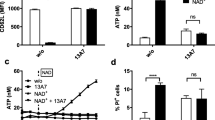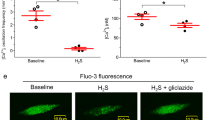Abstract
Reducing osmolarity by 35% increased 3H-taurine efflux from Swiss 3T3 fibroblasts from 0.5% to a peak of 5.7%. The presence of ATP (10–100 µM; EC50 1.5 µM) increased taurine efflux up to 10%, and decreased the set point for hyposmotically stimulated taurine release (HTR). ATP potentiation was mimicked by UTP, reduced by addition of suramin and pyridoxal phosphate-6-azophenyl-2′,4′-disulphonic acid (PPADS) and unaffected by ADP, β,γ-methylene-ATP (β,γ-ATP) or 2-methylthio-ATP (Me-ATP), suggesting its mediation by purinergic P2Y2 and P2Y4 metabotropic receptors. Under isosmotic conditions ATP increased the cytosolic [Ca2+] ([Ca2+]i) markedly, but did not increase taurine release. HTR was independent of external Ca2+ but was reduced (by 56–59%) by BAPTA-AM, thapsigargin-induced depletion of intracellular Ca2+ stores, or phospholipase C (PLC) inhibition. Blockade of calmodulin (CaM) or calmodulin kinase II (CaMKII) reduced HTR by 54% and 76%, respectively. The ATP-mediated potentiation was prevented fully by all these treatments. HTR was reduced by 30–50% by blockers of protein tyrosine kinases (AG18), phosphoinositide 3-kinase (PI3K) (wortmannin), p21rho (toxin B), p21rho-kinase (Y27632) and the stress-activated kinase p38 (PD169316). ATP-mediated potentiation was reduced similarly by these blockers. Simultaneous inhibition of PI3K and CaMKII abolished HTR. Altogether, these results suggest a modulatory effect of ATP, probably exerted by a potentiation of the Ca2+-dependent fraction of HTR. This fraction has as signalling elements a PLC-dependent [Ca2+]i increase, resulting from Ca2+ released from thapsigargin-sensitive internal stores, followed by activation of CaM/CaMKII reactions. The Ca2+/ATP effect operates only when the Ca2+-independent, tyrosine kinase-mediated pathway is already activated. Suggested elements of cross-talk between the two pathways are PLC, PI3K and CaMKII.








Similar content being viewed by others
References
Barr AJ, Marjoram R, Xu J, Snyderman R (2002) Phospholipase C-beta 2 interacts with mitogen-activated protein kinase kinase 3. Biochem Biophys Res Commun 293:647–652
Boudreault F, Grygorczyk R (2002) Cell swelling-induced ATP release and gadolinium-sensitive channels. Am J Physiol 282:C219–C226
Cardin V, Lezama R, Torres-Marquez ME, Pasantes-Morales H (2003) Potentiation of the osmosensitive taurine release and cell volume regulation by cytosolic Ca2+ rise in cultured cerebellar astrocytes. Glia 44:119–128
Darby M, Kuzmiski JB, Panenka W, Feighan D, MacVicar BA (2003) ATP released from astrocytes during swelling activates chloride channels. J Neurophysiol 89:1870–1877
Dezaki K, Tsumura T, Maeno E, Okada Y (2000) Receptor-mediated facilitation of cell volume regulation by swelling-induced ATP release in human epithelial cells. Jpn J Physiol 50:235–241
Erb L, Liu J, Ockerhausen J, Kong Q, Garrad RC, Griffin K, Neal C, Krugh B, Santiago-Perez LI, Gonzalez FA, Greham HD, Turner JT, Weisman GA (2001) An RGD sequence in the P2Y2 receptor interacts with αVβ3 integrins and is required for Go-mediated signal transduction. J Cell Biol 153:491–501
Feranchak AP, Roman RM, Schwiebert EM, Fitz JG (1998) Phosphatidylinositol 3-kinase contributes to cell volume regulation through effects on ATP release. J Biol Chem 273:14906–14911
Feranchak AP, Fitz JG, Roman RM (2000) Volume-sensitive purinergic signaling in human hepatocytes. J Hepatol 33:174–182
Franco R, Torres-Marquez ME, Pasantes-Morales H (2001) Evidence for two mechanisms of amino acid osmolyte release from hippocampal slices. Pflugers Arch 442:791–800
Franco R, Lezama R, Ordaz B, Pasantes-Morales H (2004) Epidermal growth factor receptor is activated by hyposmolarity and is an early signal modulating osmolyte efflux pathways in Swiss 3T3 fibroblasts. Pflugers Arch 447:830–839
Galietta LJ, Falzoni S, Di Virgilio F, Romeo G, Zegarra-Moran O (1997) Characterization of volume-sensitive taurine- and Cl−-permeable channels. Am J Physiol 273:C57–C66
Gatof D, Kilic G, Fitz JG (2004) Vesicular exocytosis contributes to volume-sensitive ATP release in biliary cells. Am J Physiol 286:G538–G546
Ginnan R, Singer HA (2002) CaM kinase II-dependent activation of tyrosine kinases and ERK1/2 in vascular smooth muscle. Am J Physiol 282:C754–C761
Grynkiewicz G, Poenie M, Tsien RY (1985) A new generation of Ca2+ indicators with greatly improved fluorescence properties. J Biol Chem 260:3440–3450
Hazama A, Shimizu T, Ando-Akatsuka Y, Hayashi S, Tanaka S, Maeno E, Okada Y (1999) Swelling-induced, CFTR-independent ATP release from a human epithelial cell line: lack of correlation with volume-sensitive Cl− channels. J Gen Physiol 114:525–533
Hazama A, Fan HT, Abdullaev I, Maeno E, Tanaka S, Ando-Akatsuka Y, Okada Y (2000) Swelling-activated, cystic fibrosis transmembrane conductance regulator-augmented ATP release and Cl-conductances in murine C127 cells. J Physiol (Lond) 523:1–11
Hisadome K, Koyama T, Kimura C, Droogmans G, Ito Y, Oike M (2002) Volume-regulated anion channels serve as an auto/paracrine nucleotide release pathway in aortic endothelial cells. J Gen Physiol 119:511–520
Hoffmann EK, Pedersen SF (1998) Sensors and signal transduction in the activation of cell volume regulatory ion transport systems. Contrib Nephrol 123:50–78
Huwiller A, Wartmann M, van den Bosch H, Pfeilschifter J (2000) Extracellular nucleotides activate the p38-stress-activated protein kinase cascade in glomerular mesangial cells. Br J Pharmacol 129:612–618
Huwiller A, Rolz W, Dorsch S, Ren S, Pfeilschifter J (2002) Extracellular ATP and UTP activate protein kinase B/Akt cascade via the P2Y2 purinoceptor in renal mesangial cells. Br J Pharmacol 136:520–529
Jacques-Silva MC, Rodnight R, Lenz G, Liao Z, KongQ, Tran M, Kang Y, Gonzalez FA, Weisman GA, Neary JT (2004) P2X7 receptors stimulate AKT phosphorylation in astrocytes. Br J Pharmacol 141:1106–1117
Jakab M, Furst J, Gschwentner M, Botta G, Garavaglia ML, Bazzini C, Rodighiero S, Meyer G, Eichmueller S, Woll E, Chwatal S, Ritter M, Paulmichl M (2002) Mechanisms sensing and modulating signals arising from cell swelling. Cell Physiol Biochem 12:235–258
Junankar PR, Karjalainen A, Kirk K (2002) The role of P2Y1 purinergic receptors and cytosolic Ca2+ in hypotonically activated osmolyte efflux from a rat hepatoma cell line. J Biol Chem 277:40324–40334
Kim HD, Bowen JW, James-Kracke MR, Landon LA, Camden JM, Burnett JE, Turner JT (1996) Potentiation of regulatory volume decrease by P2U purinoceptors in HSG-PA cells. Am J Physiol 270:C86–C97
Lambert IH (2004) Regulation of the cellular content of the organic osmolyte taurine in mammalian cells. Neurochem Res 29:27–63
Lang F, Busch GL, Ritter M, Volkl H, Waldegger S, Gulbins E, Haussinger D (1998) Functional significance of cell volume regulatory mechanisms. Physiol Rev 78:247–306
Lazarowski ER, Boucher RC, Harden TK (2003) Mechanisms of release of nucleotides and integration of their action as P2X- and P2Y-receptor activating molecules. Mol Pharmacol 64:785–795
Light DB, Capes TL, Gronau RT, Adler MR (1999) Extracellular ATP stimulates volume decrease in Necturus red blood cells. Am J Physiol 277:C480–C491
Light DB, Dahlstrom PK, Gronau RT, Baumann NL (2001) Extracellular ATP activates a P2 receptor in Necturus erythrocytes during hypotonic swelling. J Membr Biol 182:193–202
Loveday D, Heacock AM, Fisher SK (2003) Activation of muscarinic cholinergic receptors enhances the volume-sensitive efflux of myo-inositol from SH-SY5Y neuroblastoma cells. J Neurochem 87:476–486
Mitchell CH, Carre DA, McGlinn AM, Stone RA, Civan MM (1998) A release mechanism for stored ATP in ocular ciliary epithelial cells. Proc Nat Acad Sci USA 95:7174–7178
Mongin AA, Kimelberg HK (2002) ATP potently modulates anion channel-mediated excitatory amino acid release from cultured astrocytes. Am J Physiol 283:C569–C578
Moore AL, Roe MW, Melnick RF, Lidofsky SD (2002) Calcium mobilization evoked by hepatocellular swelling is linked to activation of phospholipase Cγ. J Biol Chem 277:34030–34035
Morales-Mulia S, Cardin V, Torres-Marquez ME, Crevenna A, Pasantes-Morales H (2001) Influence of protein kinases on the osmosensitive release of taurine from cerebellar granule neurons. Neurochem Int 38:153–161
Musante L, Zegarra-Moran O, Montaldo PG, Ponzoni M, Galietta LJ (1999) Autocrine regulation of volume-sensitive anion channels in airway epithelial cells by adenosine. J Biol Chem 274:11701–11707
Pasantes-Morales H, Franco R (2002) Influence of protein tyrosine kinases on cell volume change-induced taurine release. Cerebellum 1:103–109
Pedersen SF, Beisner KH, Hougaard C, Willumsen BM, Lambert IH, Hoffmann EK (2002) Rho family GTP binding proteins are involved in the regulatory volume decrease process in NIH3T3 mouse fibroblasts. J Physiol (Lond) 541:779–796
Perez-Samartin AL, Miledi R, Arellano RO (2000) Activation of volume-regulated Cl− channels by ACh and ATP in Xenopus follicles. J Physiol (Lond) 525:721–734
Phillis JW, O’Regan MH (2002) Evidence for swelling-induced adenosine and adenine nucleotide release in rat cerebral cortex exposed to monocarboxylate-containing or hypotonic artificial cerebrospinal fluids. Neurochem Int 40:629–635
Rhee SG (2001) Regulation of phosphoinositide-specific phospholipase C. Annu Rev Biochem 70:281–312
Roman RM, Wang Y, Lidofsky SD, Feranchak AP, Lomri N, Scharschmidt BF, Fitz JG (1997) Hepatocellular ATP-binding cassette protein expression enhances ATP release and autocrine regulation of cell volume. J Biol Chem 272:21970–21976
Roman RM, Feranchak AP, Salter KD, Wang Y, Fitz JG (1999) Endogenous ATP release regulates Cl− secretion in cultured human and rat biliary epithelial cells. Am J Physiol 276:G1391–G1400
Sabirov RZ, Dutta AK, Okada Y (2001) Volume-dependent ATP-conductive large-conductance anion channel as a pathway for swelling-induced ATP release. J Gen Physiol 118:251–266
Soltoff SP (1998) Related adhesion focal tyrosine kinase and the epidermal growth factor receptor mediate the stimulation of mitogen-activated protein kinase by the G-protein-coupled P2Y2 receptor. Phorbol ester or [Ca2+]i elevation can substitute for receptor activation. J Biol Chem 273:23110–23117
Taylor AL, Kudlow BA, Marrs KL, Gruenert DC, Guggino WB, Schwiebert EM (1998) Bioluminescence detection of ATP release mechanisms in epithelia. Am J Physiol 275:C1391–C1406
Tilly BC, Gaestel M, Engel K, Edixhoven MJ, de Jonge HR (1996) Hypo-osmotic cell swelling activates the p38 MAP kinase signalling cascade. FEBS Lett 395:133–136
Van der Wijk T, De Jonge HR, Tilly BC (1999) Osmotic cell swelling-induced ATP release mediates the activation of extracellular signal-regulated protein kinase (Erk)-1/2 but not the activation of osmo-sensitive anion channels. Biochem J 343:579–586
Van der Wijk T, Tomassen SF, Houtsmuller AB, de Jonge HR, Tilly BC (2003) Increased vesicle recycling in response to osmotic cell swelling Cause and consequence of hypotonicity-provoked ATP release. J Biol Chem 278:40020–40025
Wang Y, Roman R, Lidofsky SD, Fitz JG (1996) Autocrine signaling through ATP release represents a novel mechanism for cell volume regulation. Proc Natl Acad Sci USA 93:12020–12025
Acknowledgements
We wish to thank Claudia Peña-Segura and Alicia Sampieri for their excellent technical assistance. This study was supported in part by grants No. IN206403-3 from DGAPA, UNAM; and 3586-N and 34886-M from CONACyT.
Author information
Authors and Affiliations
Corresponding author
Rights and permissions
About this article
Cite this article
Franco, R., Rodríguez, R. & Pasantes-Morales, H. Mechanisms of the ATP potentiation of hyposmotic taurine release in Swiss 3T3 fibroblasts. Pflugers Arch - Eur J Physiol 449, 159–169 (2004). https://doi.org/10.1007/s00424-004-1322-1
Received:
Revised:
Accepted:
Published:
Issue Date:
DOI: https://doi.org/10.1007/s00424-004-1322-1




